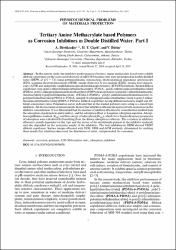| dc.contributor.author | Büyüksağiş, Aysel | |
| dc.contributor.author | Çiçek, H.Y. | |
| dc.contributor.author | Bütün, V. | |
| dc.date.accessioned | 2019-12-20T06:03:04Z | |
| dc.date.available | 2019-12-20T06:03:04Z | |
| dc.date.issued | 2019 | en_US |
| dc.identifier.citation | Buyuksağiş, A. & Çiçek, H. Y. & Bütün, V. “Tertiary Amine Methacrylate Based Polymers As Corrosion Inhibitors İn Double Distilled Water. Part I”, Protection Of Metals And Physical Chemistry Of Surfaces, 2019, 5, Pp. 951–962. © Pleiades Publishing, Ltd., 2019. Issn 2070-2051, Doı: 10.1134/S2070205119050058 | en_US |
| dc.identifier.uri | https://www.doi.org/10.1134/S2070205119050058 | |
| dc.identifier.uri | https://hdl.handle.net/11630/7545 | |
| dc.description.abstract | In the current study, the inhibitive performances of tertiary amine methacrlate based water soluble diblock copolymers on the corrosion behaviour of AISI 304 stainless steel were investigated in double distilled water (DDW, at pH = 7.6) using potentiodynamic polarisation, electrochemical impedance spectroscopy (EIS), scanning electron microscopy (SEM), energy dispersive X-ray analysis (EDX), atomic force microscopy (AFM) and inductively coupled plasma optical emmision spectrometry (ICP OES) methods. Related diblock copolymers were poly[2-(dimethylamino)ethylmethacrylate] (PDMA), poly[2-(diethylamino)ethylmethacrylate] (PDEA), poly[2-(diisopropylamino)ethylmethacrylate] (PDPA) homopolymers and poly[2-(dimethylamino)ethylmethacrylate]- b-poly[methylmethacrylate] (PDMA-b-PMMA), poly[2-(diethylamino)ethylmethacrylate]-bpoly[ methylmethacrylate] (PDEA-b-PDMA) and poly[2-(diisopropylamino)ethylmethacrylate]-b-poly[2-(dimethylamino) ethylmethacrylate] (PDPA-b-PDMA). Diblock copolymers having different molecular weight and different comonomer ratios. Polarisation curves indicated that all the studied polymers were acting as a mixed type inhibitors. All electrochemical measurements showed that inhibition efficiencies increased with an increase in the inhibitor concentration. It was determined that the increase of inhibitor efficiency by concentration resulted from the adsorption of polymers to metal surface, and the adsorption fitted to Langmuir adsorption equation. Adsorption equilibrium constant (Kads) and free energy of adsorption(ΔGads), which were thermodynamic parameters of adsorption were calculated by benefiting from the drawn adsorption isotherms. The variation in inhibitive efficiency mainly depended on the type and the nature of the substituents present in the inhibitor molecule and also depended on the molecular weight of the inhibitors. The best inhibition in DDW showed VB207 diblock copolymer. Surface images obtained with SEM, EDX and AFM methods, determined by verifying these results that inhibitors decreased the dissolution of metal, and prevented the corrosion. | en_US |
| dc.language.iso | eng | en_US |
| dc.publisher | Pleiades Publishing, Ltd | en_US |
| dc.identifier.doi | 10.1134/S2070205119050058 | en_US |
| dc.rights | info:eu-repo/semantics/restrictedAccess | en_US |
| dc.subject | Tertiary amine methacrylate | en_US |
| dc.subject | Corrosion | en_US |
| dc.subject | Polymer | en_US |
| dc.subject | AISI 304SS | en_US |
| dc.subject | Adsorption | en_US |
| dc.subject | Inhibitor | en_US |
| dc.title | Tertiary amine methacrylate based polymers as Corrosion Inhibitors in double distilled water. Part I | en_US |
| dc.type | article | en_US |
| dc.relation.journal | Protection of Metals and Physical Chemistry of Surfaces, | en_US |
| dc.department | Fen-Edebiyat Fakültesi | en_US |
| dc.authorid | 0000-0001-8911-7157 | en_US |
| dc.identifier.volume | 5 | en_US |
| dc.identifier.startpage | 951 | en_US |
| dc.identifier.endpage | 962 | en_US |
| dc.relation.publicationcategory | Makale - Uluslararası Hakemli Dergi - Kurum Öğretim Elemanı | en_US |
| dc.contributor.institutionauthor | Büyüksağiş, Aysel | |



















